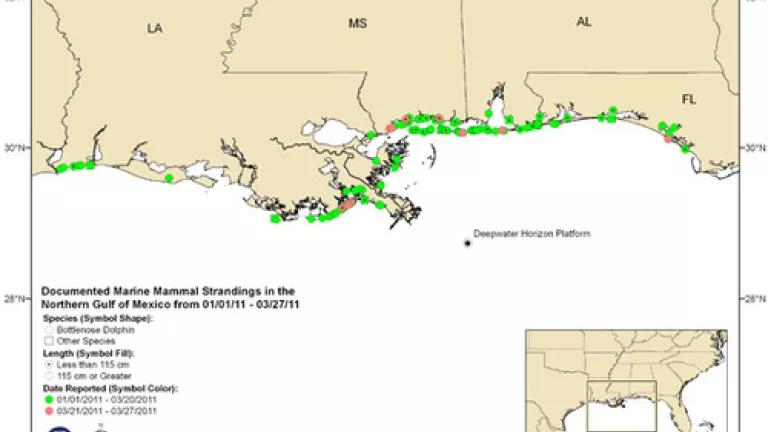
Counting dead marine mammals in the Gulf of Mexico, or any body of water, is extremely difficult because most marine mammals never make it to shore. They perish at sea, perhaps dozens of miles from any beach, in deep water. Animals whose bodies are recovered in a die-off are often said to represent “the tip of an iceberg” – simply the ones that, by chance, have stranded and been discovered and then reported to authorities.
Which begs the question: if more than 130 bodies have been recovered so far in the Gulf's bottlenose dolphin die-off, how many animals are actually dying? Just how big is that iceberg in the Gulf?
Today, a group of well-respected marine biologists gave us a first look at the answer, and it’s not pretty. Their paper, which has just appeared in the journal Conservation Letters, pores over five years of stranding records for 14 Gulf species and, for each one, compares the number of reported bodies with what we know about their population size and survival rates. They conclude that, on average, only one in fifty whales and dolphins that die at sea are recovered on the Gulf’s shores.
Not surprisingly, the discovery rate varies by species, depending on such factors as habitat preference, physical size, and the sociality of the animals. Your odds of finding a dead sperm whale are slightly better than average (about one body for every thirty deaths), of finding an offshore striped or spinner dolphin are far worse (less than one in 200). The paper doesn’t assign a number to bottlenose dolphins, no doubt because of their complicated demographics in the northern Gulf. But presumably nearshore dolphins would have one of the best rates of discovery (the highest rate given in the paper is about one in sixteen), and offshore dolphins perhaps among the worst, with dolphins on the shelf lying somewhere in the middle.
Regardless of which numbers you pump in, the paper suggests that thousands of Gulf dolphins are dying.
This frightening math makes determining the provenance of the 130 stranded animals all the more urgent. As I’ve said before, the dolphin communities that have made their homes in the Gulf’s bays, sounds, and estuaries are small and semi-isolated, and the death of even a few babies can have outsized effects on the group. The shelf and offshore populations are larger but not vast, and the death of hundreds, let alone thousands, of animals would far exceed the government’s estimate of what they can reasonably sustain.
To be sure, the Conservation Letters paper is a first take, and investigators will have to account for greater monitoring efforts made since the Deepwater Horizon blowout, among other things. But it demonstrates the need to start thinking beyond the shore, especially if investigators determine that the BP spill may be responsible.
As the authors note, “Many media reports have suggested that the spill caused only modest environmental impacts, in part because of a low number of observed wildlife mortalities, especially marine mammals.” In the Exxon Valdez case, the government came up with a multiplier to account for the numbers of undiscovered dead animals that the oil giant was liable for. If BP is to blame for even a fraction of these strandings – not only of the bottlenose dolphins this year, but of the whales and dolphins found during the spill itself – the government will have to face the same grim mathematics now.
